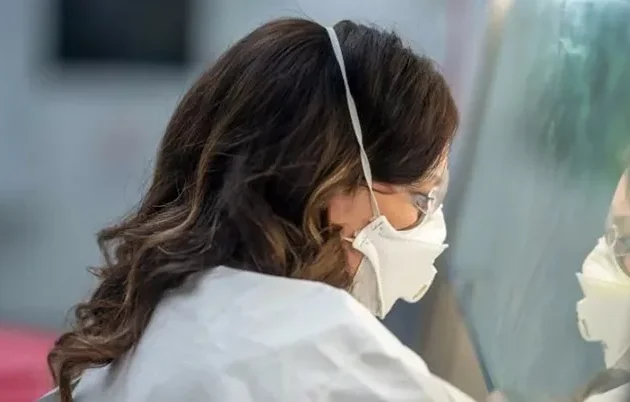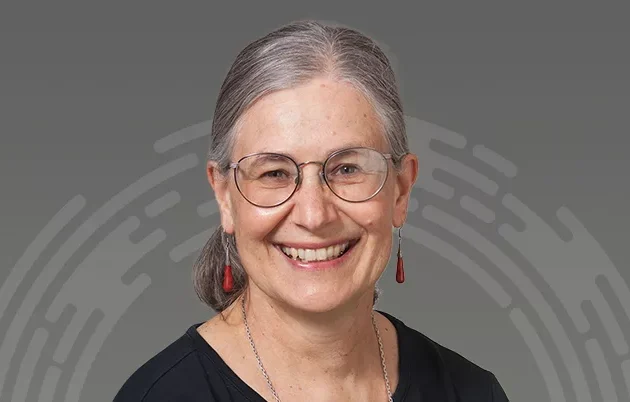Now a professor in the Department of Biochemistry in the UW–Madison College of Agricultural and Life Sciences, she has for more than 40 years studied what she calls “the language of life,” observed most readily in viruses. From 1994 to 2012, she served as director of the UW Institute for Molecular Virology, one of the nation’s leading virology research centers. By 2012, Palmenberg found herself at the top of her field, in demand as a presenter and financially secure as a result of patents based on her work.
Then cancer happened. Her first sign of a problem was a viral infection she contracted while traveling in Europe. Although she recovered, she soon began to experience back pain, and six weeks later, she collapsed and was hospitalized. Two weeks of tests at the UW Carbone Cancer Center led to a heavy diagnosis: Stage 4 aggressive T-cell lymphoma. Paralyzed by then, Palmenberg and her oncologist, Julie Chang, MD (PG ’03, ’05), an associate professor of medicine at the UW School of Medicine and Public Health, knew her aggressive disease demanded aggressive treatment.
“Dr. Chang hammered me with every drug in the arsenal to keep me alive,” says Palmenberg, who underwent five months of intensive chemotherapy.
Once the cancer subsided, she spent a year learning to walk again. Happily, the ordeal proved worth it.
“Despite some collateral damage from the disease and the treatment, I’m now cancer free,” says Palmenberg. “UW Carbone saved my life and made it possible for me to return to work in my lab.”
That work involves taking viruses apart and putting them back together, as Palmenberg describes it. “Viruses are simple organisms. Studying them is akin to learning about internal combustion by studying a lawn mower rather than an automobile,” she explains.
“Viruses also are very good at finding and exploiting vulnerabilities in other cells. By studying them, we can identify points where we can try to intervene — with drug treatments, for example — or with preventive measures like vaccines.”
Palmenberg was an early adopter of computer modeling to make laboratory work more efficient. “We still have to do the experiments and gather the data,” she says. “But the computer allows us to plan that work more strategically. It helps us predict which experiments will be most likely to produce useful results.”
Currently she is studying Rhinovirus C, identified in 2009 during surveillance of Severe Acute Respiratory Syndrome (SARS) in China. Rhino C is a common cold virus that binds with cells that display a certain protein on their surface. Palmenberg is collaborating with James Gern, MD, a School of Medicine and Public Health professor of medicine and pediatrics, and a pediatric allergy, asthma and immunology specialist at American Family Children’s Hospital. They’ve observed that in certain childhood asthma patients, Rhino C provokes an exaggerated immune response that can lead to hospitalization with severe respiratory symptoms. Palmenberg is optimistic the work will result in a vaccine against Rhino C.
“Virtually everything we know about the foundations of life — the genetic code, the structure of RNA and DNA — has been learned through viruses,” she says. Because her work has yielded lucrative patents administered by the Wisconsin Alumni Research Foundation, she has made it a priority to “reinvest in the place that has allowed me to make discoveries.”
Women’s athletics and graduate student education have benefited from Palmenberg’s generosity. After her cancer experience, she added UW Carbone to her list.
“I’m grateful for the medical care I received, and I also was impressed with all the support services available to patients and families,” she says. “Cancer treatment is exhausting and stressful. People come here from all over the region, even the country, so they may not have a local support system. The non-medical patient and family services make a big difference, so that’s where I decided to focus my financial support.”
As a scientist with the same insatiable curiosity she has had since childhood, Palmenberg is eager to keep learning and discovering. As a cancer survivor, she is grateful she’s able to continue working and committed to supporting programs that will make the cancer experience a bit less arduous for others.


